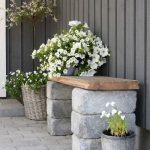Are you looking for ideas on how to construct natural landscaping on a slope? Landscaping on a steep incline can be challenging, but with the right techniques and design, you can create a stunning and functional natural landscape. In this article, we will explore the concept of natural landscaping, discuss the unique challenges of landscaping on a slope, and provide tips and ideas for creating a beautiful and sustainable outdoor space.
Landscaping is an art form that allows individuals to create beautiful outdoor environments that are in harmony with nature. Natural landscaping, in particular, focuses on creating outdoor spaces that mimic the beauty and functionality of natural ecosystems. When it comes to landscaping on a slope, there are additional considerations such as soil erosion prevention, retaining wall construction, plant selection, and water feature incorporation.
Assessing the slope of your landscape is crucial in determining the best approach for your natural landscaping project. By evaluating the angle and shape of the slope, you can effectively plan out how to design staircases or terraced steps that not only enhance the aesthetics but also provide accessibility and usability. Additionally, understanding the unique conditions of the slope will guide you in selecting appropriate plants and groundcover to ensure sustainability and minimal maintenance.
Assessing the Slope
Landscaping on a slope can present both challenges and opportunities. Before embarking on a natural landscaping project on a slope, it is essential to assess the slope properly to determine the best approach for landscaping. One of the first steps involves evaluating the steepness and angle of the slope. This will help in determining what type of natural landscaping features can be incorporated effectively.
Another important aspect of assessing the slope is considering potential water runoff. The slope may impact how water flows through the landscape, affecting plant growth and soil erosion. By understanding the patterns of water flow, it is possible to plan for proper drainage and irrigation systems as part of the natural landscaping design.
In addition to evaluating the physical aspects of the slope, it’s crucial to take into account any environmental factors that may influence the landscape design. This includes factors such as sunlight exposure, wind patterns, and soil composition. Understanding these environmental elements will guide in selecting suitable plants, trees, and other features for a successful natural landscaping project on a slope.
| Aspect | Consideration |
|---|---|
| Slope Steepness | Evalute steepness and angle before designing |
| Water Runoff | Plan for proper drainage and irrigation systems |
| Environmental Factors | Select suitable plants based on sunlight exposure, wind patterns, and soil composition |
Designing a Natural Landscape Step
When it comes to natural landscaping on a slope, designing a staircase or terraced steps is crucial for creating an aesthetically pleasing and functional outdoor space. The first step in this process is to carefully assess the slope and determine the best approach for landscaping. Once you have evaluated the slope, it’s time to start planning the design of your natural landscape steps.
One effective technique for creating a staircase or terraced steps on a slope is to use materials that blend seamlessly with the natural surroundings. This can include using locally-sourced stone, wood, or other natural materials that complement the overall aesthetic of the landscape. Additionally, consider incorporating curves and gentle slopes into the design to create a more natural and organic look.
Another important consideration when designing natural landscape steps on a slope is ensuring proper drainage to prevent erosion. This can be achieved by incorporating gravel or other permeable materials into the design, as well as strategically placing plants and groundcover to help absorb excess water. By paying attention to these details, you can create a staircase or terraced steps that not only enhance the beauty of your landscape but also contribute to its sustainability.
| Aspect | Consideration |
|---|---|
| Materials | Use locally-sourced stone, wood, or other natural materials |
| Drainage | Incorporate gravel and permeable materials for proper drainage |
| Curves | Create a more natural and organic look by using curved designs |
Selecting Plants
When designing natural landscaping on a slope, selecting the right indigenous plants and groundcover is crucial for creating a sustainable and visually appealing environment. Choosing plants that are native to the area will not only thrive in the local climate and soil conditions but will also support the ecosystem by providing food and habitat for local wildlife. Here are some tips for selecting the best plants and groundcover for your natural landscape step on a slope ideas.
Native Plant Selection
One of the key elements of natural landscaping is using native plants that are well-adapted to the local environment. Indigenous plants have evolved to thrive in specific climate and soil conditions, making them low-maintenance and resilient choices for landscaping on a slope. Before selecting plants, research the native vegetation in your area and choose species that will complement each other in terms of height, color, texture, and blooming season.
Groundcover Options
Groundcover plays an important role in stabilizing the soil on a sloped landscape while adding visual interest and reducing maintenance needs. When choosing groundcover for a natural landscape step on a slope, consider options such as drought-tolerant grasses, low-growing shrubs, or spreading perennials. Groundcover plants should be able to prevent erosion, suppress weeds, retain moisture, and create a seamless transition between different levels of the landscape.
Sustainability Considerations
In addition to selecting indigenous plants and groundcovers, it’s important to consider sustainability when choosing plant species. Look for drought-resistant varieties that require minimal watering once established, as well as plants with deep root systems that can anchor the soil and withstand erosion. By prioritizing eco-friendly plant selections, you can create a natural landscape that is not only visually striking but also environmentally responsible.
By carefully selecting native plants and groundcover for your natural landscaping project on a slope, you can establish a beautiful and sustainable environment that harmonizes with its surroundings while minimizing maintenance requirements. Paying attention to factors such as native species, groundcover options, and sustainability considerations will ensure that your natural landscape step not only survives but thrives in its unique setting.
Building Retaining Walls
Constructing retaining walls is a crucial aspect of landscaping on a slope as they help create terraced levels and prevent soil erosion. The first step in building retaining walls is to assess the slope and determine the appropriate height and placement for the walls. It’s important to consider factors such as drainage, soil composition, and the overall design of the natural landscape steps when planning the construction of retaining walls.
When it comes to selecting materials for constructing retaining walls, there are several options to consider. Natural stone, concrete blocks, and timber are popular choices that lend themselves well to creating a natural look that complements the surrounding environment. Each material has its own advantages and considerations, so it’s essential to choose based on durability, cost, and aesthetic appeal.
In terms of construction techniques, it’s important to ensure that the retaining walls are built with stability and longevity in mind. Proper drainage behind the walls is crucial to prevent water buildup and potential collapse.
Additionally, using geogrids or anchoring systems can provide added support to the retaining walls, especially for taller structures. When considering how to construct natural landscaping step on a slope ideas, it’s essential to consult with landscaping professionals or do thorough research to ensure that the retaining walls are built according to best practices for safety and functionality.
Soil Erosion Prevention
Natural landscaping on a slope can be a beautiful and sustainable way to enhance the natural beauty of a property. However, one of the key challenges in landscaping on a slope is preventing soil erosion and maintaining the integrity of the landscape.
Without proper soil erosion prevention strategies, the natural landscape can quickly become damaged and lose its functionality. In this section, we will explore some effective strategies for preventing soil erosion and preserving the beauty of a natural landscape on a slope.
Strategic Planting
One of the most effective ways to prevent soil erosion on a sloped landscape is through strategic planting. By selecting indigenous plants with deep root systems, you can help stabilize the soil and prevent erosion. These plants also help absorb excess water, reduce surface runoff, and add visual appeal to the landscape. Additionally, using groundcover plants can help minimize bare soil exposure and protect against erosion caused by wind and rain.
Contouring and Terracing
Another strategy for preventing soil erosion on a sloped landscape is through contouring and terracing. By creating gradual contours along the slope and building terraced steps, you can slow down water runoff and create flat areas where vegetation can thrive. This approach not only helps in preventing erosion but also adds visual interest to the landscape design.
Mulching
Mulching is an essential practice for preventing soil erosion in natural landscaping on a slope. Applying mulch to the exposed soil helps retain moisture, suppresses weed growth, promotes healthy plant growth, and protects the soil from erosion caused by heavy rains or strong winds. Using organic mulch materials such as wood chips or straw also contributes to improving soil fertility over time.
By implementing these strategies for preventing soil erosion on a sloped landscape, you can ensure that your natural landscaping remains beautiful, functional, and sustainable for years to come. With careful planning and maintenance, your landscape will not only endure but thrive in its natural environment.
Incorporating Water Features
Adding water features to a natural landscaping project on a slope can add an extra layer of beauty and tranquility to the outdoor space. Here are some ideas for incorporating natural-looking water features into your landscape design:
- Cascading waterfall: Create a stunning focal point by building a cascading waterfall that follows the natural contours of the slope. Using natural stone, create a series of small pools that flow into each other, mimicking the appearance of a mountain stream. This not only adds visual interest but also provides soothing sound effects.
- Pond or stream: If you have enough space and resources, consider adding a pond or stream to your landscape. A meandering stream that winds its way down the slope can create a sense of movement and liveliness while providing habitat for aquatic plants and wildlife. A pond at the bottom of the slope can serve as a reflective surface, enhancing the overall tranquil atmosphere.
- Rain garden: A rain garden is a strategic way to capture and filter stormwater runoff while adding beauty to your landscape. By planting native wetland plants in a depression at the base of the slope, you can create an attractive and functional feature. The plants will help absorb excess water and prevent erosion, while also attracting beneficial pollinators.
Incorporating water features into your natural landscaping project on a slope requires careful planning and consideration of the local ecosystem. By selecting appropriate features like waterfalls, ponds, streams or rain gardens, you can enhance the natural beauty of your outdoor space while promoting sustainability. With proper maintenance, these water elements will continue to complement your landscape design for years to come.
Maintenance
Maintaining natural landscaping on a slope can be a bit challenging, but with the right techniques, you can ensure the longevity and beauty of your landscape. Here are some essential tips for maintaining your natural landscaping on a slope:
- Regular Inspections: Conduct regular inspections of your slope to check for any erosion or damage. Look for signs of soil erosion, plant health, and structural integrity of retaining walls.
- Weed Control: Keep an eye out for weeds and invasive plants that can disrupt the natural balance of your landscape. Regularly remove any unwanted vegetation to maintain the health and aesthetic appeal of your natural landscaping.
- Pruning and Trimming: Proper pruning and trimming of plants is essential for maintaining the overall look and health of your natural landscape. Trim back overgrown branches, dead foliage, and shape plants as needed to keep them in optimal condition.
- Soil Management: Pay attention to soil quality and make necessary amendments to maintain a healthy growing environment for your plants. Adding organic matter, mulching, and proper drainage management are important aspects of soil maintenance on a slope.
- Watering: Proper watering is crucial for the survival of plants on a slope. Consider installing irrigation systems or hand-watering as needed to ensure that all plants receive adequate moisture.
By following these maintenance tips, you can preserve the beauty and ecological balance of your natural landscaping on a slope while ensuring its long-term sustainability.
Conclusion
In conclusion, natural landscaping on a slope offers a unique and beautiful way to enhance outdoor spaces while also addressing the challenges of working with uneven terrain. As discussed throughout this article, the key to successful natural landscaping on a slope lies in careful planning, thoughtful design, and the selection of appropriate materials and plants.
By carefully assessing the slope, designing functional steps or terraces, selecting indigenous plants, building retaining walls, preventing soil erosion, and incorporating water features, it is possible to create a sustainable and visually appealing landscape that harmonizes with the surrounding environment.
One of the most important aspects of creating a successful natural landscaping project on a slope is choosing indigenous plants and ground cover that can thrive in such conditions. These plants not only add to the beauty of the landscape but also contribute to its sustainability by requiring minimal maintenance and resources. Additionally, incorporating water features such as a small pond or stream can further enhance the natural feel of the landscape while also providing valuable habitat for local wildlife.
Embarking on your own natural landscaping project on a slope may seem daunting at first, but with careful planning and attention to detail, it is achievable. By following the tips and guidelines outlined in this article, you can create a unique outdoor space that not only enhances your property but also benefits the local environment.
Whether you are looking to create an inviting garden path or transform an entire hillside into a stunning natural oasis, with some creativity and hard work, you can bring your vision to life.
Frequently Asked Questions
How Do You Build Steps in a Sloping Garden?
Building steps in a sloping garden requires careful planning and execution. Start by determining the best location for the steps and mark out the area. Then, dig out individual step locations, making sure they are level and even.
Install a base of gravel and sand to provide a stable foundation for the steps. Finally, lay the chosen material for the steps, whether it’s wood, stone, or another building material.
How Do You Install Stone Steps on a Slope?
Installing stone steps on a slope involves similar steps to building any type of steps in a sloping garden. However, when using stone as the building material, it’s important to ensure that each step is firmly set into place with mortar or another suitable adhesive.
The natural unevenness of stones may require careful adjustment and leveling during installation to create safe and functional steps.
How Do You Make Natural Stone Steps?
Making natural stone steps typically involves selecting and shaping natural stones to fit together securely as individual steps. Due to the irregular shapes of natural stones, careful planning and fitting are necessary to create sturdy and safe steps.
Natural stone steps can add a rustic and charming touch to any garden or landscape design. Proper installation is crucial to ensure their longevity and safety for regular use.

Welcome to my gardening blog! I am passionate about plants and enjoy sharing my knowledge and experiences with others. In this blog, I will write about everything related to gardening, from tips on how to get started to updates on my own garden projects.





